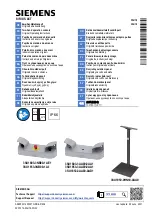
15
9. POST switch
Push this switch to set the AUX 1 control post-fader or release it to set the AUX 1 pre-fader. The pre-fader se ng is
preferable if you want to use the AUX 1 send as stage monitor, in order to have your stage mix independent from MAIN
MIX.
10. AUX 2 control (send to FX post)
This control sends the signal to the AUX 2 output and to the internal DIGITAL EFFECT PROCESSOR. This signal is post-
fader, in other words it depends on the posi on of the channel FADER.
11. PAN control
It adjusts the amount of channel signal sent to the le versus the right outputs. Use it to posi on the sound origin in a
panoramic stereo scene.
12. PEAK detector and SOLO ac ve
This LED has two func ons:
If the PEAK LED lights permanently this means that you have ac vated the SOLO switch of this channel.
If the PEAK LED
fl
ashes this means that the input signal is near to the CLIPPING point.
IMPORTANT:
if the LED PEAK
fl
ashes reduce the level of the input signal using the GAIN control.
13. SOLO switch
This switch allows you to hear signals through your headphones or control room outputs and to display the level on LED
meters. Use the SOLO in live sets to pre-listen channels before they are fed into the mix or just to check out a par cular
channel any me during a session. You can solo as many channels at a me as you like.
IMPORTANT:
The solo signal is pre-fader if SOLO MODE is in PFL posi on, so what you check is the signal entering the
channel. The solo signal is post-fader if SOLO MODE is in AFL posi on, so what you check is the signal sent from the
channel fader to the MAIN MIX.
14. MUTE/ALT 3-4 switch
The dual-purpose MUTE/ALT 3-4 switch serves two func ons: mu ng and as an extra stereo bus:
If you want to mute the channel switch this bu on, disengage the ALT 3-4 (51) switch and TO MIX (46) switch and don’t
use the ALT 3-4 outputs.
If you want to create an alternate mix switch this bu on to assign the channels to the ALT 3-4 mix, connect the ALT3-
4 outputs (45) to whatever des na on you desire, the ALT3-4 fader (44) will control the level of your alternate mix,
engaging the ALT 3-4 switch (51), the signals will appear also at the CONTROL ROOM and PHONES outputs.
If you want to create a subgroup with several channels (when doing live sound or mixdown, it’s o en handy to control
the level of several channels with one knob), switch this bu on to simply assigning these channels to the ALT 3-4 mix
and engaging the TO MIX switch (46), the ALT3-4 fader (44) will control the level of your sub-group.
15. FADER LEVEL control
It adjusts the level of the channel signal and sends it to the MAIN MIX and to the CTRL ROOM/PHONES outputs.
16. MIC LINE L MONO Input
This is a female JACK/XLR combo connector that accepts a balanced microphone XLR input from almost any type of
microphone, or a line JACK input that accepts a balanced or unbalanced line level input signal from almost any line
source. If the LINE R jack is not inserted, this channel operates like a MONO channel with this input as a single signal
source. Wiring is the same of previous paragraphs.
17. LINE R Input
This is a ¼” (6.3mm) jack connector, which accepts a balanced or unbalanced line level input signal from almost any line
source. This is used only in presence of LINE L jack input to use the channel as STEREO.
18. STEREO CHANNEL GAIN Control
The gain control adjusts the input sensi vity of the mic and line inputs. This allows the signal from mics and instruments
to be adjusted to op mal internal levels. If the signals are plugged into the XLR input there is a 0 dB of gain with the
knob turned all way down, rising up to 40 dB of gain fully up. When connected to the jack input of any channels, there
is 20 dB of a enua on all way down and 20 dB of gain fully up, with a unity gain (0 dB) if centered.
19. BAL control
It adjusts the amount of channel signal sent to the le versus the right outputs if the channel is used as MONO, or it
fades the LEFT or RIGHT signal amount if the channel is used as STEREO.
20. PRESETS selector and display
The internal PROFEX digital e
ff
ect processor is built around a powerful DSP and 24bit AD/DA converters. It includes 16
di
ff
erent presets of studio-grade e
ff
ect algorithm, each one featuring 16 di
ff
erent varia ons of the internal parameters,
for a total of 256 e
ff
ects available.
















































